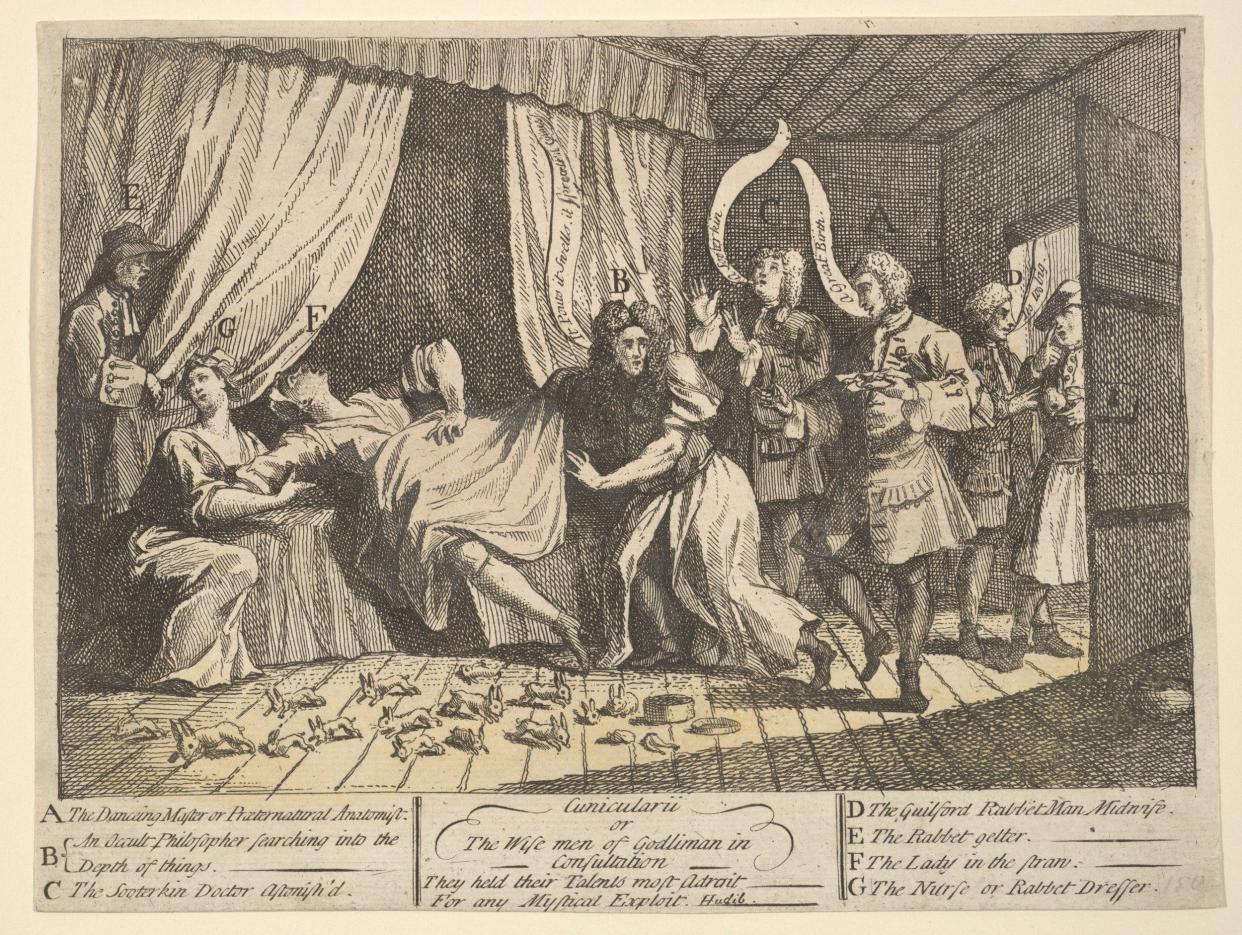The woman who gave birth to rabbits – or so England thought

Mary Toft was a woman from Godalming, who achieved notoriety in 1726 when she purportedly gave birth to a litter of rabbits. In reality, the animal parts Toft “delivered” were being surreptitiously inserted into her vagina prior to each parturition. But this mysterious, apparently miraculous case attracted widespread attention, from the press to the Royal household, who sent their own physician to Surrey to witness these “births” for himself. For roughly two months, from late September through early December, Toft pulled the wool – nay, fur – over the eyes of a cadre of bombastic, supposedly enlightened and educated men of science. And when the truth came out, she blamed a variety of accomplices – more powerful women in her life, such as her mother-in-law – who’d promised her that the inevitable fame would change her life for the better.
Noémi Kiss-Deáki’s debut novel is a sprightly but savage tale that’s inspired by, and intrudes upon, this real-life case. (The author is Finnish, but she writes in English, with fluency and elegance.) It’s fashionable today to turn historical female figures into feisty fictionalised heroines, treating them like 21st-century “girlbosses” in period drag. Not only is this clunky, but it makes for lazy writing and storytelling. And so I approached Mary and the Rabbit Dream with caution.
What joy, then, to find Kiss-Deáki taking a more original approach, one that twists the traditional historical novel into something supple, smartly self-conscious and (as she explains it herself in her afterword) “in tune with modern research”. In this case, the research is the work of historian Karen Harvey, whose book The Imposteress Rabbit Breeder (2020) illuminates the context and meaning of Toft’s ruse: how it happened, what it meant, and how the consequences of it played out for all involved. This provides the blueprint for Kiss-Deáki’s playfully mischievous narrative, within which she amalgamates facts from the historical record, the fictionalised voices of all involved, and some of the “conclusions” Harvey reached about the case.
Set entirely in the 18th century, documenting the entire deception from start to finish, Kiss-Deáki throws us headlong into the era, but as the narrator of the tale, she keeps one foot firmly on 21st-century ground, which allows her to drift in and out of a tone of hindsight-filled omniscience. Put bluntly, she can have her cake and eat it, using occasional modern idioms without the taint of anachronism. Take Mary’s headstrong mother-in-law Ann Toft, who’s described as a woman who “wants to set the system on fire”. This, Kiss-Deáki assures her readers, “is not how Ann Toft herself would word it in early 18th-century England, but that is what she wants to do.”
It’s 1726, and 25-year-old Mary is pregnant. She has been married for six years, and has already given birth to three children, only one of whom has survived. She’s illiterate and uneducated, and her life is “harsh and miserable”. Like the other women in her community, she works in the hop fields surrounding Godalming for a penny a day. This is a world within which the gulf between the rich and the poor is unimaginably vast – a gulf that Kiss-Deáki nimbly boils down to specific experiences or observations. The handkerchief, for example, of one of the important and powerful men who come to investigate the rabbit births is made of an astonishingly fine fabric that Mary “has never even heard of, let alone touched”.

Yet this is also a world in which a woman giving birth to rabbits is “considered a mixture of strange event and scientific experiment”; an era in which ambitious and powerful men of science still wrestle with “superstition, mystery and idiotic ideas about women’s mysterious bodies”. At least these men can afford such lofty thoughts. Women such as Mary are mired in the baser realities of their own viscera. “Each and every one of the fraudulent births are physical events,” Kiss-Deáki reminds us. It’s something the male doctors poking and prodding Mary don’t stop to consider: “To Mary Toft, each and every one is an overwhelmingly physical and painful event.”
Such repetition, as if to drive home a point, is common in the novel, and it creates a compelling sense of rhythm that helps the story to romp along. It’s split into traditional chapters, but these chapters are then further broken down into short paragraphs – sometimes only a single sentence – each of which is separated from the next by white space on the page. That clipped choppiness serves a dual purpose: it’s reminiscent of the hacked-up rabbit parts that emerge so violently from Mary’s innards, as if a similar brutality had been enacted on the text itself; yet it’s also a reminder of authorial intrusion of the very best kind. Mary and the Rabbit Dream is a delight: cunning, curious, cunicular.
Mary and the Rabbit Dream is published by Galley Beggar at £12.99. To order your copy for £10.99, call 0808 196 6794 or visit Telegraph Books


